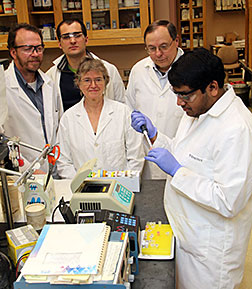- Number 431 |
- January 26, 2015
Ames scientists use genetic markers to discover the rhizosphere

Marit Nilsen-Hamilton, an Ames Laboratory
scientist and professor in the Roy J Carver
Department of Biochemistry, Biophysics and
Molecular Biology at Iowa State University,
works with her research team to develop
methods of non-destructive imaging of
biological systems. From left: lab manager
and technician Lee Bendickson; graduate
research assistant Ivan Geraskin;
Marit Nilsen-Hamilton (front), Ames
Laboratory scientist George Kraus (back);
and graduate research assistant
Judhajeet Ray (foreground).
It’s a science lesson so fundamental that we teach it to small children, planting bean seeds in Styrofoam cups: plants take nutrients from the soil to grow.
It is surprising, then, that the complex interchange between the microorganisms in soils and the cellular activities of plants’ root systems, what scientists call the rhizosphere, remains one of science’s great mysteries.
“We want to know how plants and microbes in the soil talk to each other,” said Marit Nilsen-Hamilton, an Ames Laboratory scientist and professor in the Roy J Carver Department of Biochemistry, Biophysics and Molecular Biology at Iowa State University. “We know they’re communicating with each other, but how? Multicellular communities are vastly more complex than we currently understand. How do we go about finding out?”
Nilsen-Hamilton, working in partnership with other researchers at DOE's Ames Laboratory, Lawrence Berkeley National Laboratory, and Iowa State University is on the brink of creating a technology that would allow a clearer look at the entire rhizosphere system through the use of aptamers, short strands of genetic material that bind to a specific target molecule.[Breehan Gerleman Lucchesi, 515.294.9750,
breehan@ameslab.gov]
